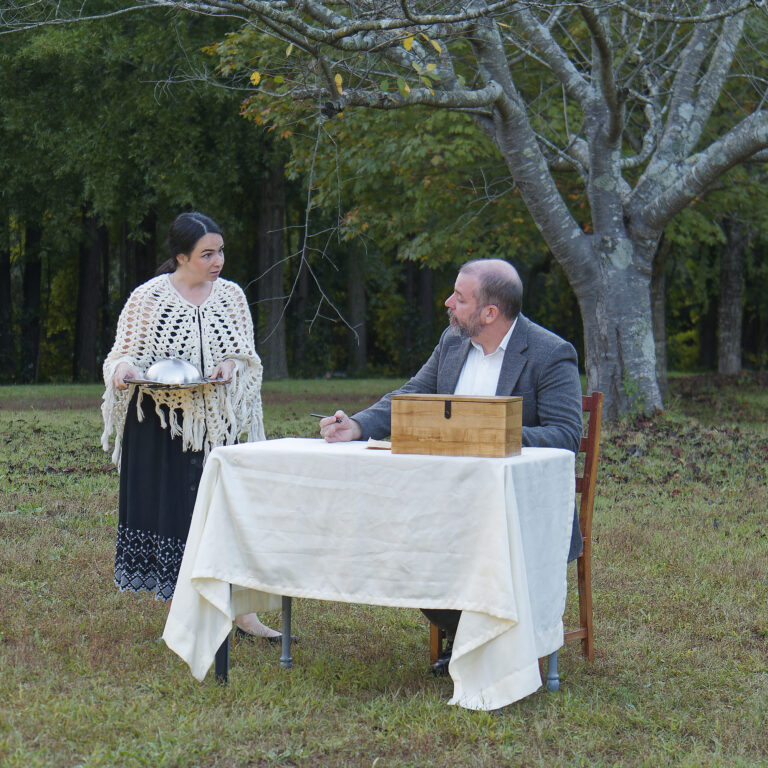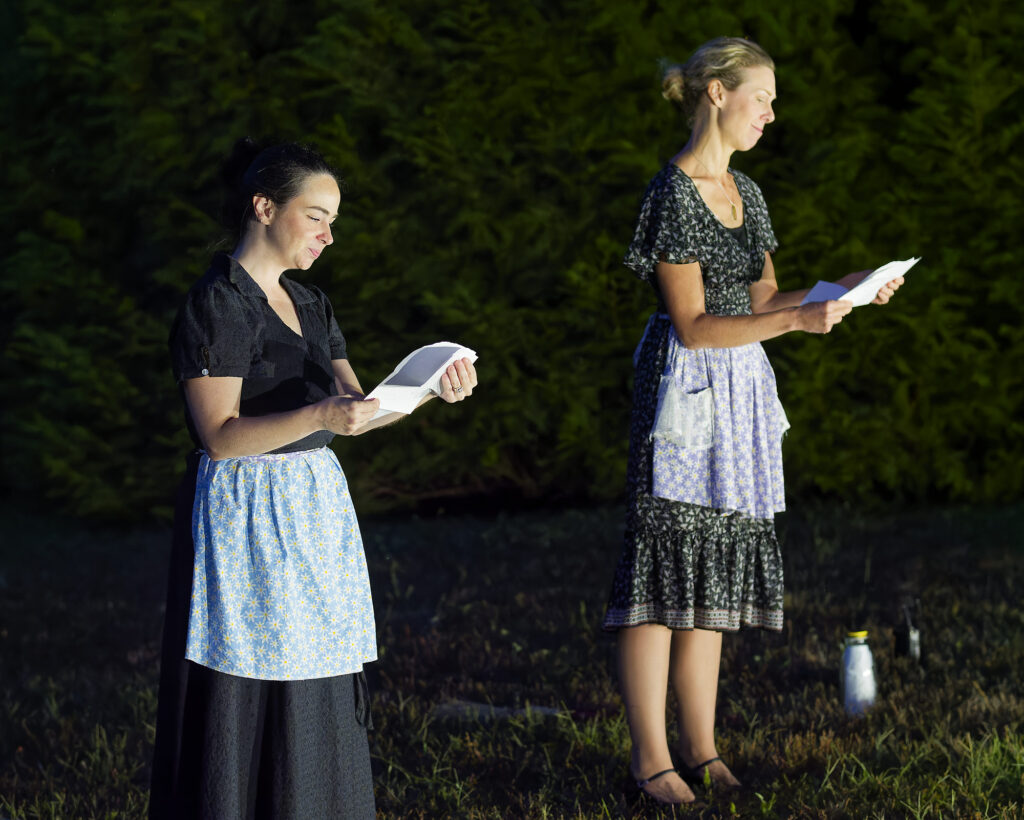Above photo shows a scene from “World War I: Just One Day More.” All photos courtesy of Burning Coal Theatre.
At Oakwood Cemetery, Burning Coal performs plays about the lives of people buried in the graveyard
By Elizabeth Brignac
The Oakwood Cemetery series produced by Burning Coal Theatre is about as local as theater can be. Burning Coal has been performing the series every year for the past 15 years. Written by local playwrights, each series is unique to the year it is performed and based on the lives and deaths of people buried in the cemetery. They are acted and produced by an entirely local cast and crew. Last year’s production, “Butterfly Wings,” focused on people involved in a 1903 shooting on Fayetteville Street. This year, “Bringing Them Home” centers on the lives and deaths of soldiers buried in Oakwood Cemetery whose lives were cut short in battle.
This year’s five short plays are based on stories in the book “Bringing Them Home,” written by Oakwood historians Bruce G. Miller and Robin Simonton. Adapted by Burning Coal development director Abbe Fralix and artistic director Jerome Davis and directed by Susan Gross, the plays portray fictionalized accounts of moments in the lives (and deaths) of young men who fought in the Civil War, the Spanish American War, World War I, World War II and the Vietnam War.

The Oakwood Cemetery Location
At the performance I attended, the Oakwood Cemetery location initially felt like a funeral, complete with foldout chairs set up with an aisle up the center leading to a table with a coffin-like box at the front. It felt like an observance to honor the people whose lives are commemorated in the plays. The location offers the serendipitous benefits and drawbacks of outdoor theater. A bird, visible at the top of a nearby tree, for example, sang at the beginning of the September 29 production in a way that added to its poignancy. Airplanes and helicopters flew overhead from time to time, which occasionally interfered with our ability to hear but added to the atmosphere, particularly during the last short play, “Vietnam: Daniel and Curtis.”
More importantly, the location brings home the fact that these soldiers were our young men. “I am buried right over there in the Beechwood section,” says one soldier, pointing to that part of the cemetery. A character in “WWI: Just One More Day” refers to the neighborhood where he lived, gesturing in its direction relative to the cemetery. And “WWII: The Ashe Avenue Boys” centers on several young men who lived on Ashe Avenue near Pullen Park and were all killed in 1944. The effect is to remind us that these soldiers in the graves surrounding the viewers could easily be our own high school and college students—our kids and their friends.

“Bringing Them Home”
The title “Bringing Them Home,” like the book on which it is based, refers to the difficulties families had in bringing home the bodies of their family members killed in far-away battles. The first play, “The Civil War: Gettysburg,” for example, focuses on the efforts by Dr. Rufus Weaver of Gettysburg, Pennsylvania, to return the bodies of Iowa Michigan Royster of Raleigh and other soldiers killed at the Battle of Gettysburg to their families after the war. “WWI: Just One More Day” tells the story of two Raleigh soldiers whose families made the effort required to bring their bodies back from the French battleground where they died in World War I—and the story of one whose family, for unknown reasons, chose to leave his body in France.
But the title also refers to the series’ unapologetic demand that the U.S. refuse to send soldiers into unnecessary wars. It shows respect for the soldiers and their service—the play’s opening sequence has each character place a red flower in a memorial box at the front. It also acknowledges that serving in war was, in many cases, each soldier’s choice. “Old Hickory never backed down from nothing!” says one character, referring to his hero, Andrew Jackson, and emphasizing that it was his own decision to emulate Jackson when he chose to serve in World War I.
But the series also questions the necessity of the U.S. having fought many of the wars that brought these and other soldiers’ lives to an end. It suggests that often the reasons governments go to war are political or superficial. At the end of the play, for example, one character bluntly tells the audience that Theodore Roosevelt involved the U.S. in the Spanish American War to gain himself military experience and improve his odds of winning a campaign for the presidency. “WWI: Just One More Day” similarly questions the need for soldiers to have fought and died in World War I. And “Vietnam: Daniel and Curtis” emphasizes the U.S. government’s breach of trust in misrepresenting the war to the people—including the soldiers who died fighting it.

Creating Heroes
The play also interrogates the use of heroism as a tool that survivors and governments use for their own ends, particularly in “The Spanish American War: Creating a Hero.” This play focuses on Worth Bagley, the first American soldier to die in the Spanish American War, who was lionized at the time as a hero. The character emphasizes that he was only 24 when he died and had done very little except serve in the military. “I was a blank slate,” the character says, “on which they could craft their own hero.” He adds, “They weren’t honoring me,” but the made-up heroic figure they needed. The grand funerals and memorials held for Bagley, the character says, had very little to do with who he was. “Funerals don’t last forever,” he notes. “And how long does it take for people to forget a boy of 24?” In its way of honoring Bagley’s service, the play suggests, the nation deliberately forgot the young man Bagley actually was. This play definitely made me think as I drove past Bagley’s prominent memorial stone on my way out of the cemetery.
The “Bringing Them Home” series is over, but this is the type of performance viewers can expect from Burning Coal’s Oakwood Cemetery series: layered, local and nuanced. If it interests you, look for 2025’s Oakwood Cemetery performance next September. To learn more, go to burningcoal.org.


